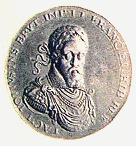


| Main Menu James Travers Gunpowder The Players Behind the Plot Augusta Frazier The Gunpowder Plot: Terror and Faith in 1605, |
| James Travers Gunpowder The Players Behind the Plot Our opinion is that this is a very finely produced quality publication with great images especially of primairy documents. The work is a survey of primary information and is a good introduction. Its problem is that it does not present complete documents for example The King's Book and Papal Bulls. It is refreshingly free from debate of controversial points leaving that up to the mind of the reader. A good survey. Review: Gunpowder: The Players behind the Plot (review)
From:
The Catholic Historical Review The accession of James I to the English throne in 1603 raised the hopes of several of the various religious factions within the realm. On one hand, English Puritans hoped that James would be the Moses ready to deliver them to a godly paradise. On the other, English Catholics also saw reason for hope. James was the son of the Catholic martyr, Mary, Queen of Scots, and had expressed support for religious toleration. James, however, dashed the hopes of both groups by proclaiming his steadfast allegiance toward moderation and the compromise embodied in the Thirty-Nine Articles. No serious reform in either direction would take place. Catholics, with perhaps the highest expectations, were the most disappointed. Moreover, the conclusion of a peace treaty with Spain in 1604 removed the possibility that they could be rescued from the throes of heresy by foreign intervention. Believing that they were in desperate straits, a small band of disappointed Catholics resolved to deliver a master stroke by which their faith could be restored. Like modern Mafiosos who knew that if they eliminated one of their enemies, they must eliminate them all, they concocted a plan to blow up the king and members of both Houses of Parliament at the opening of the session in 1605. As the session neared, however, the plotters began to have reservations, among them the realization that the explosion would also kill Catholic peers. They decided to warn them ahead of time, but, to their dismay, the peers informed the government instead. The plotters were easily rounded up and in most cases died horribly for their indiscretion. James Travers' book is not a conventional history of the plot, although one can learn most of what is known about it from reading it. Rather, Travers book is an interesting and nicely executed narrative experiment, where he treats the event as a high drama with a prologue and three acts, and pays particular attention to the roles and personalities of the leading figures. Another attractive feature of the book is that Travers' incorporates analysis of original documents and art work into his text. While the result will not reveal much that is not already known, the book is well-conceived, smoothly written, handsomely produced, and of particular interest to persons who are not specialists in the period. |
|
To return to the top click here |
|
| |||||
|---|---|---|---|---|---|
| Home | New | Story | Terrorism | Celebrations | Change |
| Clothes | Food | Language | Music | Map | Motoring |
| Destruction | Writings | Reviews | Center | Bibliography | Feedback |